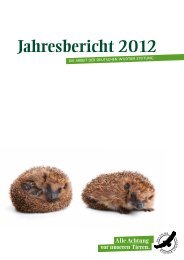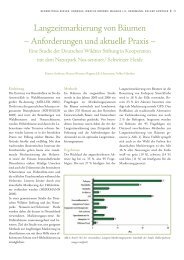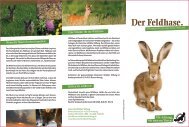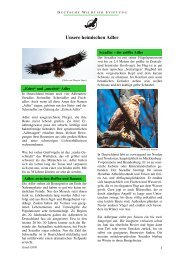Zur Biologie und Ökologie des Feldhasen - Deutsche Wildtier Stiftung
Zur Biologie und Ökologie des Feldhasen - Deutsche Wildtier Stiftung
Zur Biologie und Ökologie des Feldhasen - Deutsche Wildtier Stiftung
Sie wollen auch ein ePaper? Erhöhen Sie die Reichweite Ihrer Titel.
YUMPU macht aus Druck-PDFs automatisch weboptimierte ePaper, die Google liebt.
JEZIERSKI, W. (1967): Four cases of "Home instinct" in the European hare. Act. Theriol. 12 (12): 173-175.<br />
JEZIERSKI, W. (1988): Lagomorphe programme in Poland. Lagomorph Newslett. 8: 11-12.<br />
JEZIERSKI, W., PIELOWSKI, Z., RACZYNSKI, J., SZANIAWSKI, A. (1973): Aktuelle Richtungen der Hasenhege. Low. pol. 20/21:<br />
5-6.<br />
JOVANOVIC, V., ALEKSIC, D., KATIC, P. (1974): <strong>Zur</strong> Erforschung <strong>des</strong> Einflusses von meteorologischen Elementen auf den<br />
realen Jahreszuwachs der <strong>Feldhasen</strong> in Vojvodina. Beitr. Jagd u. Wildf. 8: 187-196.<br />
KALCHREUTER, H. (1994): Jäger <strong>und</strong> <strong>Wildtier</strong> - Auswirkungen der Jagd auf Tierpopulationen. Verlag Dieter Hoffmann.<br />
Mainz. 299 S.<br />
KAMENIK, P., BUKOVJAN, K., HALLMANNOVA, A., KARPENKO, A. (1993): Seasonal occurrence of liver steatosis and fat<br />
concentrations in the liver of field hares (Lepus europaeus PALLAS). Zeitschrift für Jagdwissenschaft. Paul Parey.<br />
Hamburg.<br />
KAUHALA, K., HELLE, P. (2000): The interactions of predator and hare populations in Finland - a study based on wildlife<br />
monitoring counts. 37: 151-160.<br />
KEITH, L. B., CARY, J. R., RONGSTAD, O. J., BRITTINGHAM, M. C. (1984): Demography and ecology of a declining snowshoe<br />
hare population. Wildlife Monographs No. 90. Supplement to The Journal of Wildlife Managemant Vol. 48 (3). Juli<br />
1984.<br />
KILIAS, H., ACKERMANN, W. (2001): On the population of the European brown hare (Lepus europaeus PALLAS) in Bavaria.<br />
Z. Jagdwiss. 47: 111-124.<br />
KING, A.A., SCHAFFER, W.M. (2001): The geometry of a population cycle: A mechanistic model of snowshoe hare<br />
demography. 82: 814-830.<br />
KINNEAR, J. E., ONUS, M. L., BROMILOW, R. N. (1988): Fox Control and Rock-Wallaby Population Dynamics. Aust. Wildl.<br />
Res. 15 (4): 435-450.<br />
KLANSEK E. (1996): Biotoprevitalisierung <strong>und</strong> neue Überlegungen zur jagdlichen Nutzung <strong>des</strong> <strong>Feldhasen</strong>. In: <strong>Zur</strong><br />
Besatzentwicklung <strong>des</strong> <strong>Feldhasen</strong> in mitteleuropäischen Niederwildrevieren 2: 31 - 36.<br />
KLANSEK, E. GANSTERER, A. (1997): Niederwild - Die Muster- <strong>und</strong> Versuchsreviere <strong>des</strong> Niederösterreichischen<br />
Lan<strong>des</strong>jagdverban<strong>des</strong>. Forschungsinstitut für <strong>Wildtier</strong>k<strong>und</strong>e <strong>und</strong> <strong>Ökologie</strong>. Niederösterreichischer Lan<strong>des</strong>-jagdverband.<br />
Wien.<br />
KNAUS, H. (1966): <strong>Zur</strong> Frage der Superfoetation beim <strong>Feldhasen</strong>. Z. Jagdwiss. 12: 1-5.<br />
KOENEN, F. (1956): Der Feldhase. Neue Brehm Bücherei Nr. 169. A. Ziemsen Verlag. Wittenberg. Lutherstadt.: 80 S.<br />
KÖTSCHE, W., GOTTSCHALK, C. (1990): Krankheiten der Kaninchen <strong>und</strong> Hasen. 4. Aufl. Fischer. Jena.<br />
KONRAD, F.-M. (1986): Krankheiten durch Bakterien. In: Gräfner, G. (Hrsg.): Wildkrankheiten. 3. Auflage. Fischer. Jena.:<br />
62-120.<br />
KREBS, C. J. (1989): Ecological methodology. Harper Collins Publishers. New York. 654 S.<br />
KREBS, C.J., BOONSTRA, R., BOUTIN, S., SINCLAIR, A.R.E. (2001): What drives the 10-year cycle of snowshoe haves?. 51: 25-<br />
35.<br />
KRONFELD, N., SHKOLNIK, M. (1996): Adaptation to life in the <strong>des</strong>ert in the brown hare (Lepus capensis). Journal of<br />
Mammalogy 77: 171-178.<br />
KUCERA, J. (1966): Umwandlung eines Rebhuhn-Hasenreviers zu einem Hasen-Fasanen-Rebhuhnrevier. Beitr. Jagd u. Wildf.<br />
5: 225-278.<br />
KWAPIL. S. (1993): Bakteriologische, virologische <strong>und</strong> parasitologische Untersuchungen am <strong>Feldhasen</strong> (Lepus europaeus<br />
PALLAS). Diss. thesis. Tierärztliche Hochschule Hannover: 141 S.<br />
LAMARQUE, F., ARTOIS, M. (1998): The European brown hare (Lepus europaeus) syndrome: about a recent epizootic. Gibier<br />
Faune Sauvage, Game Wildl.Vol. 15: 491-506.<br />
LANDA, A., STRAND, O., SWENSON, J.E., SKOGLAND, T. (1997): Wolverines and their prey in southern Norway. Journal of<br />
Zoology 75,8. Natl Research Council Canada, Research Journals, Montreal Rd, Ottawa on K1A 0R6, Canada. Landa A,<br />
Norwegian Inst Nat Res, Tungasletta 2, N-7005 Trondheim, NORWAY.: 1292-1299.<br />
LANGBEIN, J., HUTCHINGS, M. R., HARRIS, S., STOATE, C., TAPPER, S. C., WRAY, S. (1999): Techniques for assessing the<br />
ab<strong>und</strong>ance of Brown Hares (Lepus europaeus). 29: 93-116.<br />
LAVAZZA, A., SCICLUNA, M.T., CAPUCCI, L. (1996): Susceptibility of hares and rabbits to the European brown hare syndrome<br />
virus (EBHSV) and rabbit haemorrhagic disease virus (RHDV) <strong>und</strong>er experimental conditions. Journal of Veterinary<br />
Medicine Series B - Zentralblatt Für Veterinarmedizin Reihe B - Infectious Diseases and Veterinary Public Health 43<br />
(7): 401-410.<br />
83








